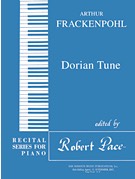

By Arthur Frackenpohl
With its simple, single-line melody, Dorian Tune, from the Robert Pace Piano Recital Series, makes an ideal first piano solo.
Early Level 1 students enjoy the piece's intriguing modal sonority with its connotations of mysterious ancient times.
Activities:
Ask students to describe the differences in "feeling" as they listen to you play:
• A few measures of "Section A," which is based on a DORIAN MODE (D - D white keys), and then
• A few measures of "Section B," which is based on a MIXOLYDIAN MODE (G - G white keys).
Encourage students to imagine a scene or story that this melody might "describe." Help students discover some of the interesting "clues" about this piece:
Q: How many Sections make up the piece?
A: Three ( A - B - A).
Q: Where does each section begin and end?
A: Section A. —- mm. 1‑8; Section B — mm. 9-16, Returning Section A — mm. 17-25.
Q: What kind of phrases make up Section A?
A: PARALLEL phrases that begin alike but end differently.
Q: Which section has longer phrases, and which section has shorter phrases?
A: Section A has longer phrases, and Section B has shorter slurred groups.
Q: The rhythm of the second half of m. 1 plus the first half of m. 2 (quarter two-eighths quarter quarter) is found in which other measures?
A: M's. 11, 15, and 16.
Q: Which measures form a MELODIC PATTERN and SEQUENCE?
A: M's. 15 & 16.
Q: What is the dynamic RANGE of the piece?
A: P to MF.
Q: What "TOUCH" is used?
A: Smooth, LEGATO.
(As students learn this piece, have them listen to and watch one another, checking for good, legato playing.)
Q: M. 9 INVERTS the rhythm and melody of which earlier measure?
A: M. 4.
Q: Does Returning Section A start louder or softer than the first Section A?
A: Softer.
Q: How are the final two measures of Dorian Tune like m. 8?
A: The melody contains the same notes, E, C, and D. The rhythmic PROPORTION is the same, but in the final two measures the notes are twice as long, making the piece "slow down" as it ends.
There are many other "clues" that make up this interesting piece.
Creating new melodies: Students will enjoy creating their own melodies, by using and varying some of the same building blocks they discover in Dorian Tune. For example, they might create melodies on a dorian mode, using the same rhythm as the original piece. The possibilities are many!
Excerpted from TEACHING TIPS, by Dr. Cynthia Pace. © All Rights Reserved.









